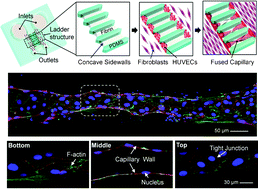In vitro formation and characterization of a perfusable three-dimensional tubular capillary network in microfluidic devices†
Abstract
This paper describes the in vitro formation and characterization of perfusable capillary networks made of human umbilical vein endothelial cells (HUVECs) in microfluidic devices (MFDs). Using this platform, an array of three-dimensional (3D) tubular capillaries of various dimensions (50–150 μm in diameter and 100–1600 μm in length) can be formed reproducibly. To generate connected blood vessels, MFDs were completely filled with fibrin gel and subsequently processed to selectively leave behind gel structures inside the bridge channels. Following gel solidification, HUVECs were coated along the gel walls, on opposite ends of the patterned 3D fibrin gel. After 3–4 days, HUVECs migrating into the fibrin gel from opposite ends fused with each other, spontaneously forming a connected vessel that expressed tight junction


 Please wait while we load your content...
Please wait while we load your content...